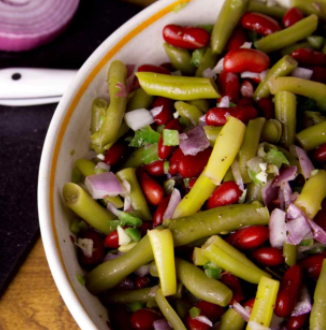
New TEFAP Fresh Produce Initiative
The U.S. Department of Agriculture has launched a new ordering option, The Emergency Food Assistance Program (TEFAP) Fresh Produce, aimed at helping those most in need receive healthy, fresh produce. Through this program, USDA will be offering boxes of pre-packed, mixed fresh produce available for TEFAP State Distributing Agencies and TEFAP eligible recipient agencies, such as food banks, to order. Single varieties of produce on the TEFAP Foods Available List, including apples, oranges, pears, potatoes, and sweet potatoes, will continue to be available to order.
The TEFAP Fresh Produce criteria will promote variety and flexibility with an emphasis on local availability. Each pre-packed, 10-12 pound box will contain a minimum of 4 different produce items to ensure variety, including both fresh fruits and vegetables, and will encourage produce that is locally grown. Locally grown will be defined as food that is produced within the same state, territory or tribal land of where it is received or so that the total distance that the product travels between the farm and the end customer is no more than 400 miles. USDA will not prescribe specific varieties of produce to be included in the boxes but will require at least 3-5 pounds of fruit and 3-5 pounds vegetables, with a 3-pound limit on root vegetables. The boxes will be expected to have a shelf life of 7-10 days once delivered, if they remain refrigerated.
For the June-September delivery periods, orders will be due to FNS by COB, April 12, 2021. All available TEFAP fund sources may be used to place orders. Regional Offices will be providing more details to TEFAP State Distributing Agencies. For more detailed information, please reference the TEFAP Fresh Produce Info Sheet, which was released on March 29, 2021.
|

Healthcare.gov Open Enrollment
The COVID-19 public health and economic crisis has left millions of families struggling to afford food and other necessities. In response to the COVID-19 Public Health Emergency, an Executive Order was issued that created a special enrollment period for health insurance through Healthcare.gov. Interested individuals and families can apply and enroll in the coverage they need through August 15th. Go to HealthCare.gov to learn more.
|
Fresh Milk Update
FDD has recently opened the TEFAP/CARES/FFCRA entitlement ordering catalogs for fresh fluid milk. Milk is a great source of vitamins and nutrients and has several health benefits. USDA now offers 1% and skim milk options in half-gallon and gallon sizes for orders using TEFAP funds. These products will be available for delivery on a weekly basis from Monday to Wednesday.
For the July-September delivery periods, orders will be due to FNS by COB, March 19th, 2021. For the October-December delivery periods, orders will be due to FNS by June 18th, 2021. The new milk products have been added to our 2021 Foods Available List.

CSFP Guide Rate Temporary Vegetable Reduction
The Commodity Supplemental Food Program (CSFP) has temporarily reduced the quantity of vegetables offered in the CSFP Maximum Monthly Distribution Rates, or Guide Rates, from 8 units to 4 units. This temporary reduction is in response to an ongoing vegetable shortage in the program. The reduction will assist FNS and State agencies with rebuilding vegetable inventories and will help ensure that CSFP participants will receive some vegetables in the monthly food package. To address the shortage, FNS has been purchasing a variety of vegetable products not typically available in the CSFP package. The CSFP shortage is due to factors in the commercial retail market such as high demand, can shortages, and label shortages.
For more detailed information, please reference the CSFP Guidance on Temporary Food Package Issuance with Modified Quantities of Vegetables memorandum, which was released on February 26, 2020. Also, read the article "New Vegetables for CSFP = New Recipes!" later in this e-letter for additional information and resources.
|

New Vegetables for CSFP = New Recipes!
The Commodity Supplemental Food Program (CSFP) is currently experiencing a vegetable product shortage due to ongoing issues with vendors’ ability to supply canned vegetables. To help address this issue, FNS is temporarily purchasing new types of vegetables for CSFP. Most of the new canned vegetables may be familiar, but there are a few that may be new to program recipients. Don’t fear – we have highlighted several recipe databases that can be used to prepare tasty recipes with these new items.
-
MyPlate Kitchen recipe database contains numerous recipes, videos, and resources that can turn a few ingredients into a healthy meal. Check out this Sweet Potato and Apple Bake.
-
Food Hero is an initiative of the Oregon SNAP-Ed program and was developed by the Oregon State University Extension Service. This database allows users to search for recipes and connect with other Food Hero users. Check out the Southern Okra Bean Stew to find a tasty way to use the canned tomatoes, okra, and corn. Canned okra can be used in place of the frozen okra that the recipe calls for.
- The Utah Food Bank has developed a robust cookbook that features foods available through CSFP. Check out their Fried Rice recipe to use any of the canned green beans or peas.
- Check out more low-cost recipe databases developed by SNAP-Ed Extensions across the nation!
Some of the new canned vegetables may contain a sodium level that is similar to what is found in the commercial market for a comparable product. To reduce the amount of sodium, drain the vegetables thoroughly and rinse them in cool water before use. This process will help to lower the sodium content by up to 20 percent! This process also works to reduce added sugar in canned sweet potatoes packed in heavy syrup.
Some of the products come in cans larger than what is typically available through CSFP. To make the most of the food and reduce waste, consider the following options:
- Heat and prepare only the amount needed and store the remaining in an airtight container in the refrigerator and use within 3 – 4 days.
- Freeze the remaining food in plastic bags, and label it with the name of the food and date. Use within 6 months.
- Consider using the entire amount of canned vegetables in a recipe. Store and freeze the leftovers in an airtight container labeled with the name of the food and date.
For a list of additional canned vegetables that will be made available through CSFP to address the product shortage, please check out the list below and the product information sheets that can be used to provide nutrition education:
|
Temporary Products
|
Pack Size
|
Sodium Level
|
Product Information Sheet
|
|
Beans, Green Cut
|
14.5 oz
|
Regular
|
Green Beans, Canned
|
|
Beans, Green Cut & Potatoes
|
38 oz
|
Regular
|
|
Beans, Green French Style
|
14.5 oz
|
Regular
|
|
Corn, Fresh Cut Kernel
|
15.25 oz
|
Regular
|
Corn, Canned
|
|
Mixed Vegetables
|
38 oz
|
Regular
|
Mixed Vegetables, Canned
|
|
Okra Cut
|
14.5 oz
|
Regular
|
Any canned vegetable
|
|
Peas w/o Salt
|
15 oz
|
Low/No Salt Added
|
Peas, Canned
|
|
Spaghetti Sauce (Pouch)
|
28 oz
|
Regular
|
Spaghetti Sauce, Canned
|
|
Sweet Potatoes
|
40 oz
|
Regular
|
Sweet Potatoes, Canned
|
|
Sweet Potatoes
|
29 oz
|
Regular
|
|
Tomatoes/Okra & Corn
|
15 oz
|
Regular
|
Tomatoes, Canned or
Corn, Canned
|
*This list is subject to change based on market availability
|

Beans – Versatile, Nutritious and Tasty – Getting the Most Out of USDA Foods!
Canned and dry beans are an excellent staple item to keep in the pantry. Packed with important nutrients, they can be used to pump up the protein in any meal. Are you looking for creative and easy ways to work beans into tasty meals and snacks? Look no further! Check out Bean Basics: A Toolkit on How to Use Beans. This toolkit contains everything you have ever wanted to know about beans! Do you know how to substitute canned beans for dry beans in recipes or why dry beans should be soaked before cooking? Discover new cooking techniques and get ideas on how to add beans to traditional recipes. There are also lots of interesting recipes and tips on incorporating beans into meals and snacks – like the Southwest Black Bean and Egg Muffins recipe or the Marinated Three Bean Salad! This toolkit can be printed as one document or select pages can be printed based on your interests and needs.
|

Pork Loin Chops, Boneless, Frozen
Figuring out what’s for dinner just got a whole lot easier! Boneless pork loin chops have been permanently added to the TEFAP Foods Available List (FAL)! This item comes frozen in a one-pound package. Pork is comparable to the nutrition composition of poultry for fat, calories and cholesterol, and it provides many nutrients including protein, B vitamins like niacin, thiamin, riboflavin, and B6, vitamin E, iron, zinc and magnesium. Boneless pork chops are a versatile ingredient and can be used in many different recipes. Whether you are in the mood for lightly seasoned baked or grilled chops with a side of vegetables and a baked potato, or a garlicky pork stir-fry with frozen peas and carrots served over brown rice, the pork chops will have you covered. You can also try slicing cooked pork chop and adding it to a salad, or chop it up and use it in chili for an extra protein punch, or build a tortilla taco layered with slices of cooked pork, lettuce, canned corn, and a little sour cream or low-fat plain yogurt. Use your imagination – pork chops can help make menu planning easy and tasty! Need a few more pork recipes for all eating occasions? Check out the Iowa Pork Association recipes and enjoy!
|

CSFP 2021 Caseload
On February 19th , USDA issued the Commodity Supplemental Food Program (CSFP) caseload and administrative grants for 2021. The 2021 national caseload level is equal to last year’s caseload level of 736,110. FNS assigns caseload in accordance with program regulations at 7 CFR 247.21 and annual appropriations legislation. In March 2021, Congress passed the American Rescue Plan Act of 2021, which provides $37 million in additional funding for CSFP on top of annual appropriations. FNS is currently determining how these additional funds will be utilized. For more information on caseload management best practices, check out the USDA's CSFP Caseload Management Webinar recording from February 20, 2020.
|

TEFAP FY21 Funding Update
On December 27, 2020, the Consolidated Appropriations Act, 2021 (P.L. 116-260, the Appropriations Act) was signed into law. This Act provides Fiscal Year (FY) 2021 funding for The Emergency Food Assistance Program (TEFAP), including $342 million for the purchase of food for TEFAP and $79.63 million to pay for TEFAP administrative costs. The Appropriations Act also provides an additional $400 million in COVID-19 supplemental funding for TEFAP. Of that $400 million, up to 20 percent, or $80 million, was available for conversion to administrative funding. TEFAP State agencies chose to accept a total of $323,970,109 as food funds and $73,279,891 as administrative funds.
|
Marieke Penterman of Penterman Farms strolls through the dairy barn on the farm.
From Bad to Gouda: Utilizing Farm to Food Bank Project Funds to Rescue Otherwise Wasted Milk
In May 2020, FNS allocated $3,752,000 for the inaugural year of TEFAP Farm to Food Bank Project grants, a new initiative created by the 2018 Farm Bill. TEFAP State agencies can use grant funding to pay for projects to harvest, process, package, or transport foods donated by agricultural producers, processors, or distributors for use by emergency feeding organizations. The Wisconsin Department of Health Services (DHS) was one of 19 TEFAP State agencies that received funding in FY 2020.
In partnership with the Hunger Task Force, Inc. (HTF, a food bank in Milwaukee County), DHS applied its Farm to Food Bank funding to mitigate a food waste issue related to the COVID-19 pandemic. As a result of closures due to social distancing measures, some milk cooperatives in the State had been forced to order member dairy farms to dump fluid milk that could no longer be utilized by shuttered restaurants, schools, and food service businesses. As many news stories noted, not only was this wasted milk a loss of thousands of hours of work spent harvesting crops and raising livestock, but also a loss of a valuable source of nutrition that could benefit those who are food insecure. DHS and HTF were quick to identify this situation as perfect for a Farm to Food Bank project, and worked to secure donated, unused milk from Penterman Farms, a dairy producer, before the farm was forced to dump it. They then worked with Holland Family Cheese in Thorp, Wisconsin, to process and package the milk into Gouda cheese, and worked with 36 food pantries in Milwaukee County to distribute it to TEFAP households.
DHS’s successful FY 2020 TEFAP Farm to Food Bank Project will continue throughout FY 2021, as the State agency was one of 24 TEFAP State agencies awarded a FY 2021 Farm to Food Bank Project grant in December 2020. DHS credits the project’s success to the strong partnerships that were already in place across the state of Wisconsin at the start of the project; and encourages TEFAP State agencies to utilize future Farm to Food Bank Project funding to facilitate similar partnerships. DHS stated, “Use your local connections to bring organizations together. These connections help strengthen our spirits as well as support our local economies and food system.” Click here for a full list of FY 2021 Farm to Food Bank Project summaries.
USDA plans to participate in the following upcoming conference:
We hope to see you there!
System Reminders
- 3/25/2021 – WBSCM Release
- 4/29/2021 – WBSCM Release
- 5/27/2021 – WBSCM Release
Planned dates for system activities are subject to change
|